Delicious and extremely unusual variety of butternut pumpkin "Trombone": how to grow and where to apply the crop
Butternut pumpkin is a real miracle for the gardener. The aromatic, sweet and juicy vegetable tastes very much like a melon. Use the product for making soups, casseroles, stuffed dishes.
In the article, we will consider the Trombone nutmeg variety, which is grown by both novice gardeners and experienced gardeners. The vegetable has an unusual curved shape, which is why it got its name. We will find out what this pumpkin is famous for and how to get a rich and tasty harvest on your site.
The content of the article
Description of pumpkin variety
An unpretentious and cold-resistant variety cultivated in the south, in the middle lane, in the Urals and Siberia. Butternut squash is grown mainly in seedlings in order to get the greatest yield.
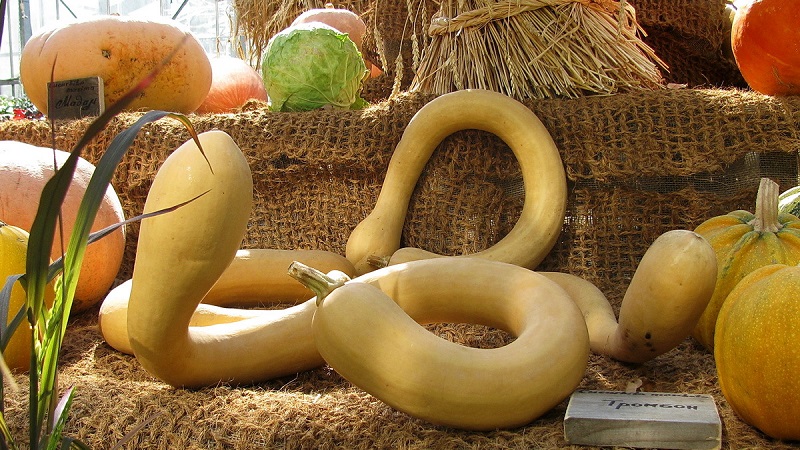
Distinctive features
Plants are compact, two bushes fit into 1 square meter... The leaf plate is wide, heart-shaped, rich green color. The lashes are of medium length, thin. The root system is powerful and develops quickly.
Fruit characteristics and yield
Original pumpkins resemble a trombone in shape... Vegetable length is about 50 cm, weight varies from 6 to 8 kg. The bark is dense and elastic, at the stage of technical ripeness the color is green, at the biological stage it is dark orange.
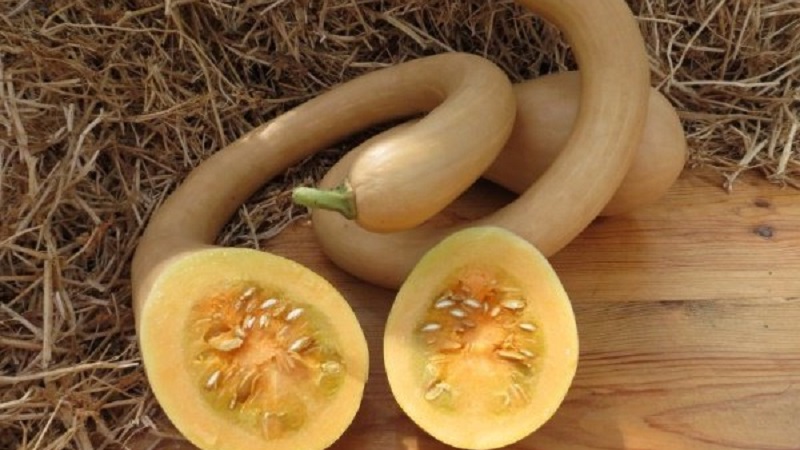
The pulp is dense and aromatic; it is actively used in cooking. The yield is good, from 1 square meter summer residents collect about 10 kg of unusual vegetables.
Interesting! In China, pumpkin is endowed with magical meaning. Since ancient times, it has been believed that a vegetable is able to absorb evil forces and protect its owner from them. Therefore, the pumpkin was often hung in front of their house, it served as a kind of talisman against troubles.
How to grow
Pumpkin is an unpretentious plant, but when planting it is necessary to take into account the basic agrotechnical rules... Consider the rules for planting and caring for the crop.
Seed planting in open ground
The first step is to disinfect the seeds... The procedure is necessary in order to destroy pathogens of dangerous diseases on the surface of seeds.
Disinfection is carried out using the drug "Formalin 40%". For 300 ml of water at room temperature, 3 g of the drug is required. The ingredients are mixed together, the seeds are placed in a tissue bag and immersed in water. After 5 minutes, the bag is taken out and left for 2 hours at room temperature.
After the seeds are taken out and dried well... Disinfection of seeds improves their germination, increases immunity to diseases and pests.
Important! After disinfection, the seeds are germinated. To do this, they are soaked in warm water for 2-3 hours, then wrapped in a damp cloth and removed to a warm place. Swollen seeds are selected for sowing and a hardening procedure is organized for them: they are placed in a freezer for 3 days. After that, they begin to transplant into open ground.
Planting a pumpkin in hilly sun beds... The best precursors for pumpkin crops are potatoes, cabbage, greens, or legumes. It is not recommended to plant the pumpkin next to upright tall plants so that they do not block the sunlight.
The best soil for culture is a mixture of sandy loam and loamy soil... Such a composition perfectly retains moisture and warms up quickly. The Trombone variety is planted according to the scheme 70x100 or 80x80 cm.It is recommended to place 2-4 seeds in one hole in order to achieve better germination.
Planting seedlings
A clean container is required to prepare seedlings... Many gardeners prefer to plant pumpkin with special peat tablets or pots. They are affordable, easy to use and made from environmentally friendly materials.
However, it is not forbidden to plant seedlings in ordinary flower pots., wooden boxes or plastic cups. The main thing is to thoroughly rinse the container and dry it before planting. Gardeners use soil from the garden or purchased mixtures as seedlings.
 note:
note:
- The garden soil is additionally fertilized with peat or humus, river sand or dry sawdust is added for looseness. Before planting, the soil is warmed up in the oven, the hot air destroys pathogenic microflora and protects against the appearance of weeds.
- Ready-made formulations already contain all the elements necessary for healthy development. Manufacturers claim that such land is disinfected and safe, but many summer residents prefer to disinfect the soil on their own.
Pumpkin seedlings are demanding on sunlight and heat... If the daylight hours are short, then additional illumination is organized using fluorescent lamps. Water the seedlings sparingly, once every 5-6 days. Before watering, it is recommended to carefully loosen the soil so that the soil becomes lighter and more airy. Seedlings are transplanted into open ground after the last spring frosts have passed. When transplanting, you need to be careful not to damage the still weak seedlings and not break fragile leaves.
About other pumpkin varieties:
Description of common pumpkin (hard-bore, pepo)
Care
During the first week, the seedlings are covered with a thin film.to protect the bushes from wind and rain. Water the plant with warm water under the root. Water should not get on fruits and leaves, otherwise the risk of diseases and pests increases. If possible, periodically, instead of water, use an infusion on onion peel or nettle leaves. These folk remedies protect the bushes from adverse factors. Stop watering 2 weeks before harvest.
Fertilize the beds after watering... The pumpkin crop loves organic feeding: manure, liquid manure, ash or compost. They improve the palatability of the fruit and accelerate ripening. Organics alternate with mineral complexes that saturate the pumpkin with nitrogen, calcium, magnesium, phosphorus. Excellent balanced dressing: "Kimira", "Zdraven", "Magic watering can". Before use, be sure to read the instructions and the recommended dosage.
Important! Dry fertilizers are absorbed much more slowly than liquid fertilizers. When in contact with the soil, dry food causes burns, therefore it is recommended to moisten the soil before fertilizing. In total, 2-3 procedures are carried out per season, mineral nutrition is alternated with organic.
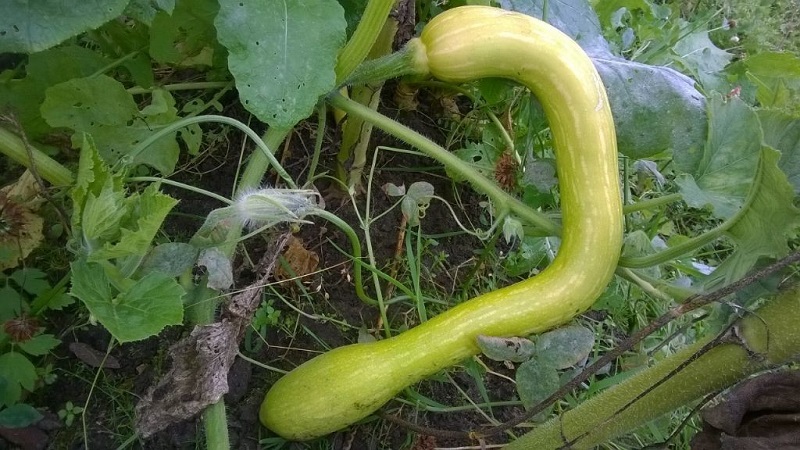
Features of cultivation and possible difficulties
In addition to watering and feeding, pumpkin needs regular loosening.... It is carried out once every 5-7 days. Loosening allows you to get rid of unwanted weeds, retain moisture in the soil and strengthen the root system. The depth of loosening is about 5-8 cm. As a rule, the operation is carried out before watering, so that the earth is saturated with oxygen. Along with this, it is necessary to maintain a healthy microflora in the beds: remove garbage, weeds, and foreign vegetation.
Forming the bush deserves special attention.... The whips of the Trombone variety are long, often confused. It is necessary to untangle them and lay them on the garden bed, sprinkling them with earth in several places. As soon as 5-6 leaves are formed, the lateral shoots are removed, leaving only those on which 2-3 fruits have already formed. Pinch the top so that all the nutrition goes to the development of pumpkins, and not the growth of green mass.
Growing tips from experienced gardeners
Summer residents recommend following the feeding regime... An overabundance of mineral components leads to a slow development of fruits, the leaves dry out and become weak.
At the first sign, wood ash is sprinkled on the beds and watered with plenty of water. In addition, gardeners advise to adhere to the following recommendations:
- follow the rules of crop rotation, do not plant a pumpkin in the same garden for more than two years in a row;
- when using water from sources, pre-warm it in the sun for three hours;
- if possible, install a drip irrigation system on the site;
- remove side shoots and unravel the whips;
- carry out preventive measures to protect against pests and diseases.
Diseases and pests
Of the insects, wireworms have the greatest negative impact.... The worms live deep underground and eat the root system of the plant. Soon the roots die, because of which the stem withers, the fruits rot. For prophylaxis, it is recommended to scatter dry eggshells over the garden bed.
During the fruiting period, spider mites, slugs and aphids are activated... Pests appear due to improper care, sharp climatic changes. Spraying with Bordeaux liquid or Oxyhom helps prevent the appearance of insects. Many insects are difficult to notice with the naked eye, so summer residents are advised to regularly inspect the bushes and fruits for the presence of uninvited "guests".
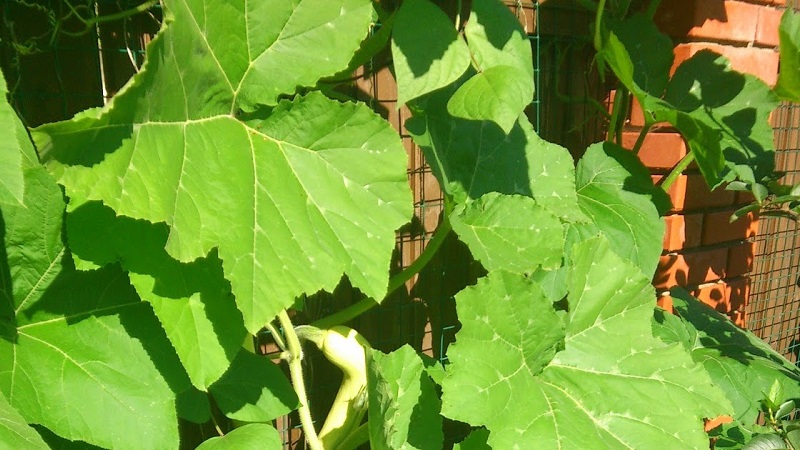
The Trombone variety is rare, but sometimes sick with powdery mildew... The disease manifests itself in the form of a white bloom, and foliar feeding with milk whey and iodine helps prevent its occurrence. Another disease - root rot, arises from an excess of fertilizers and weeds. Get rid of rot with the help of the "Hom" preparation. The agent is applied after watering, 2-3 times per season.
It can be useful:
Harvesting and application of the crop
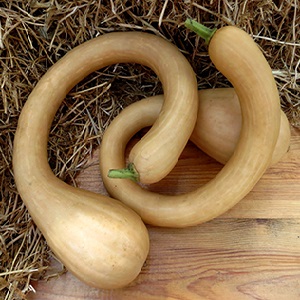 Harvested 3-3.5 months after planting... The fruits ripen gradually. First, the densest vegetables are removed, which have gained a rich orange hue. A ripe pumpkin should give off a pleasant sweetish aroma. For long-term storage, vegetables are harvested in a dark place where the humidity level is not more than 85%, and the temperature is not less than + 10 ° C. Pumpkins with damage and scratches are recommended to be eaten immediately.
Harvested 3-3.5 months after planting... The fruits ripen gradually. First, the densest vegetables are removed, which have gained a rich orange hue. A ripe pumpkin should give off a pleasant sweetish aroma. For long-term storage, vegetables are harvested in a dark place where the humidity level is not more than 85%, and the temperature is not less than + 10 ° C. Pumpkins with damage and scratches are recommended to be eaten immediately.
Delicious and healthy pumpkin juice is prepared from the vegetable... This drink has not only a vitamin composition, but also a calming effect. Also, the fruits are used for baking, their sweet taste is harmoniously combined with meat dishes, vegetable side dishes and salads. Lovers of diet food use the vegetable to make muffins, cheesecakes, pies and cakes.
Interesting! Among culinary experts, the recipe for American pumpkin pie is very popular. It is prepared for special occasions - for Christmas or Halloween. Before the advent of electricity, the delicacy was cooked on the stove; today, pumpkin pie is made in a slow cooker or on a special grill. Especially delicious pastries are obtained if you add honey or cinnamon to them.
Advantages and disadvantages of the variety
The advantages of the variety include the original appearance of the fruit., pumpkins are often used as a basis for decorative crafts. The palatability of the vegetable is high, as expected, butternut squash has a bright honey aroma and juicy pulp. Trombone rarely gets sick, shows a stable and high yield.
The variety has no significant drawbackshowever, some gardeners find that other nutmeg varieties have a more pronounced sugar flavor.
Farmers reviews
Pumpkin Trombone - a godsend for many gardeners... However, some summer residents expected great results from the cultivation of these pumpkins.
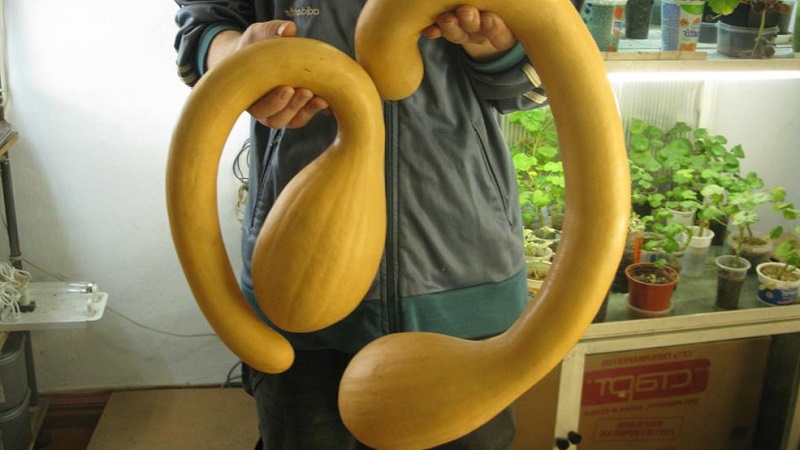
Alexander, Voronezh: “The unusual pumpkins ripened quickly, and at the end of August I had the harvest. The vegetable did not bring any trouble, it did not hurt anything. I rate my taste as a solid "4", I will definitely grow it next season ".
Maria, Sochi: “I have been planting the Trombone variety for the third year in a row. Interesting fruits look unusual, decorate the site. I cook porridge and salads from vegetables, I put some of them in the cellar for storage. Vegetables are perfectly stored until spring ".
Evgeniya, Chelyabinsk: “I plant all pumpkin varieties only in a greenhouse. Trombone is a good pumpkin, but the fruits are slowly set, and the yield is not the highest. I met varieties much better ".
Conclusion
Trombone is an excellent variety for growing in any region of the country. They planted it on hilly sun beds, watered with warm water. For the best development, the bushes are fertilized with organic matter and mineral components, and also sprayed with iodine and milk for preventive purposes.
Vegetables ripen in just 3 months, have an elongated cylindrical shape. Taste and marketability are excellent; pumpkins are used to prepare a variety of dishes.